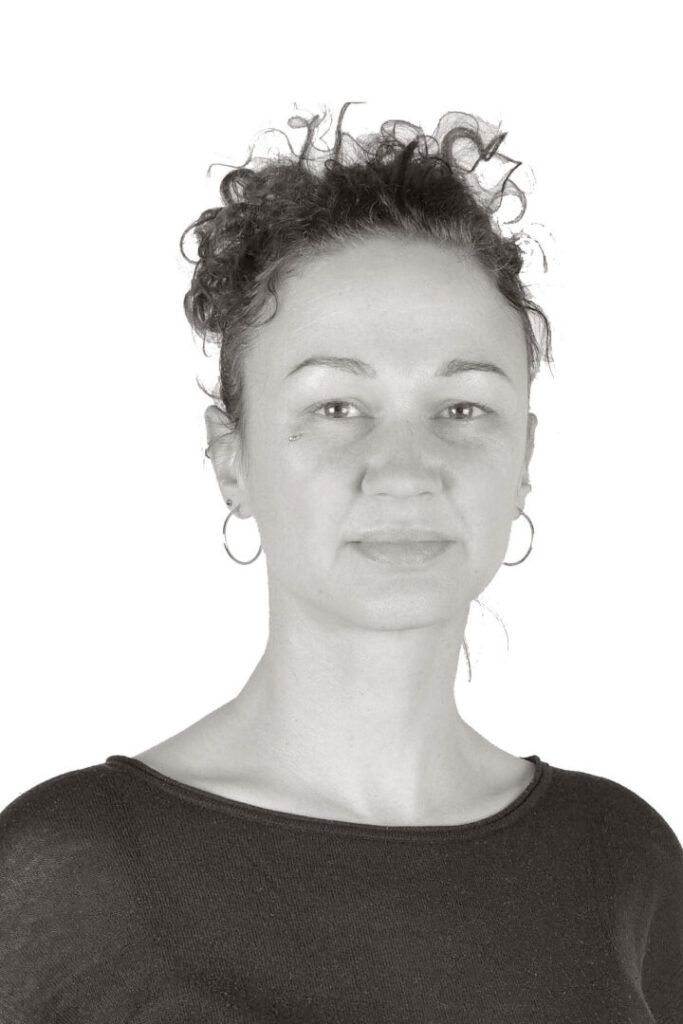Scientific lead
Lab manager
Associated researchers
Work performed in the CoMaX facility aims to better understand the history and emplacement of both terrestrial and extraterrestrial magmatic rocks, as well as the isotopic fractionations that occur during high-energy processes (evaporation/condensation, irradiation, ionisation…).
To meet the demands of this research, the experimental facility houses (1) Atmospheric-Pressure–High-Temperature, (2) Vacuum–High-Temperature equipment, and (3) High-Pressure–High-Temperature.
Due to this wide range of equipment, the CoMaX facility is divided into two complementary entities: “Experimental Cosmochemistry” and “Experimental Magmatology”.
The CoMaX facility is in the basement of the CRPG. At the local level, this facility is part of the ANATELo network (OSU OTELo); at the national level, it is part of the RéGEF (INSU), CRISTECH, Réseau des Electroniciens, Réseau de Technologie des Hautes Pressions, and RTVide networks.
The facility is accessible to all CRPG researchers and annually welcomes tens of users through internships, theses, or external collaborations. We also provide services for our academic collaborators or private partners; do not hesitate to contact us for more information.
Equipments
Equipment with pricing (ANR and ERC eligible), open to external users:
1 ATM - HT EQUIPMENT

Muffle furnace
Facility manager: François Faure et Laurent Tissandier
francois.faure@univ-lorraine.fr; laurent.tissandier@univ-lorraine.fr
Special features:
At the CRPG, we have two muffle furnaces: a Géro HTK 8.4, installed in 1994, and a Thermoconcept HTK 16/17, installed in 2013. These two furnaces can heat from 500 to 1650 °C evenly and with an accuracy of ±10 °C at 1 atm. Their large volumes (15 L) allow us to load platinum and ceramic crucibles of various shapes and sizes.
Uses:
The Thermoconcept muffle furnace allows us to dehydrate, decarbonize, and melt oxide and carbonate powders for the synthesis of glasses used as starting compositions for experiments on other machines.
The Géro muffle furnace is mainly used for experiments in sealed tubes (up to 1400 °C) in which the samples evolve in a closed system at low pressure (~1 atm).
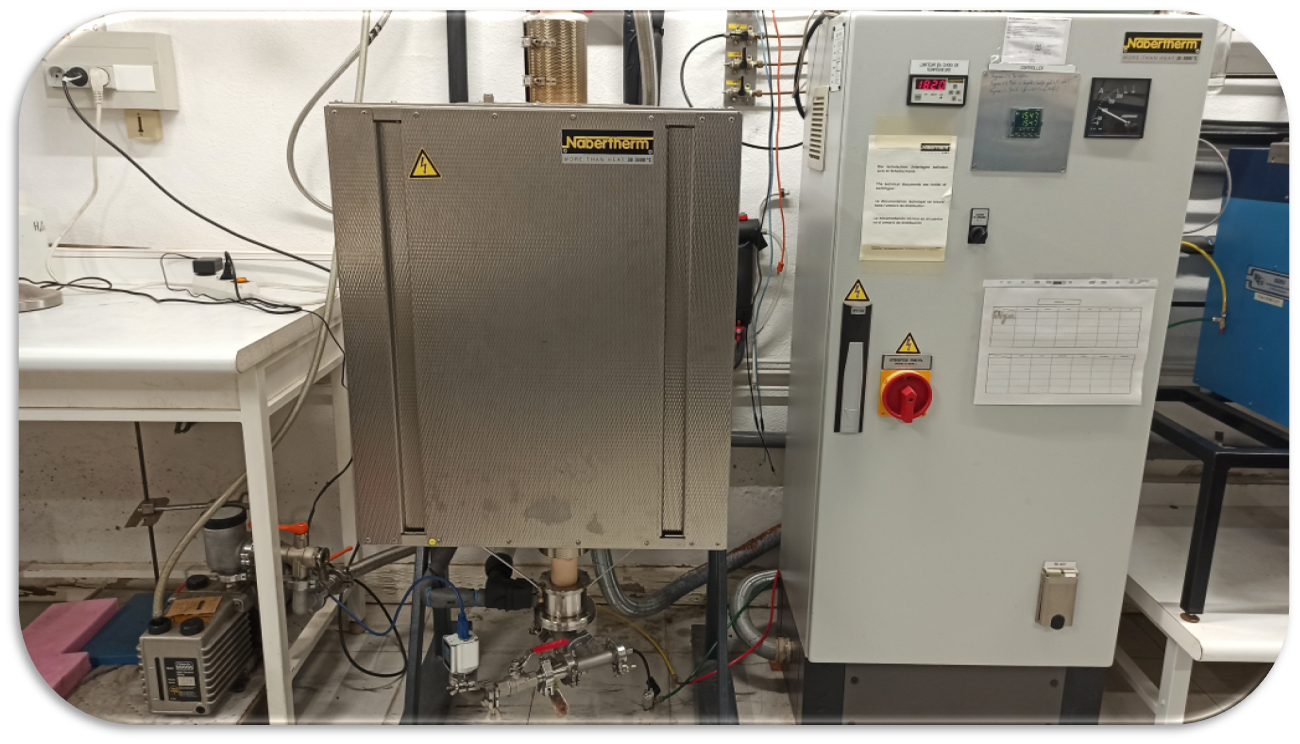
Vertical HT furnaces
Facility manager: François Faure
francois.faure@univ-lorraine.fr
Special features:
We have had four vertical furnaces installed at the CRPG from 1993 to 2009. These furnaces can heat from 500 to 1650 °C at 1 atm while controlling the furnace’s internal atmosphere. The gas mixtures introduced (CO, CO2, H2, N2, …) allow us to vary the redox state of the samples and thus observe the influence of oxygen fugacity on sample evolution. The fourth and most recently acquired furnace, a Nabertherm RHTV 120-300/18, allows us to conduct experiments under a primary vacuum (<10−1 mbar).
<Uses:
These furnaces are used to study crystal growth (https://doi.org/10.1111/maps.13830), develop phase diagrams, determine the solubilities of volatile elements (H, Dorian Thomassin’s thesis; N, Julien Boulliung’s thesis, https://doi.org/10.1016/j.gca.2020.06.020), study the evaporation of (moderately) volatile elements (ANR CSI-Planet, ANR Planet-Gem), and synthesize various standards for analytical techniques at the CRPG and other research laboratories (https://doi.org/10.1016/j.chemgeo.2018.06.008).
VacuuM – hT EQUIPMENT
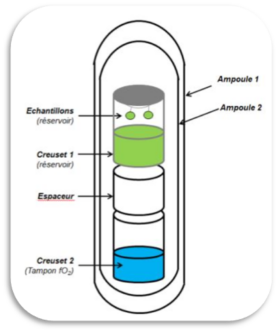
Vacuum line for sealed ampoules
Facility manager: Laurent Tissandier
laurent.tissandier@univ-lorraine.fr
Special Features:
This protocol was developed to study samples containing volatile elements whose composition must not change during the experiment. In these vacuum-sealed silica tubes, the samples are heated (up to 1400 °C) in variable redox-controlled atmospheres, and thus evolve in a closed system.
Uses:
The main studies carried out using sealed silica tubes concern the solubilities of volatile elements and actinides not found in the gaseous state at room temperature (e.g., S, Na, Hg, https://doi.org/10.1016/j.chemgeo.2025.123018; U, https://doi.org/10.1016/j.jnucmat.2020.152666), phase relationships in complex chemical systems (generally containing alkalis, https://doi.org/10.1016/j.gca.2023.12.020). Sealed silica tubes are also used to produce standards for various analytical techniques (Chavanieu et al., in prep.).
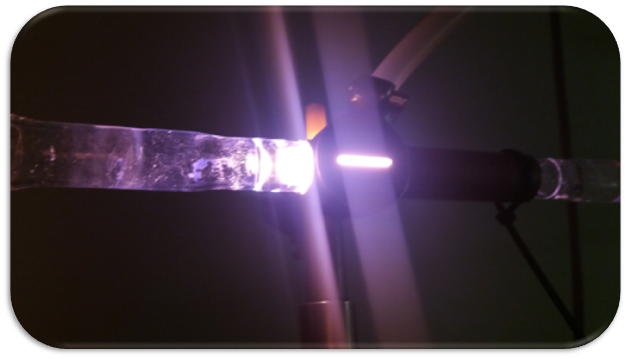
Nebulotrons
Facility manager: Laurent Tissandier
laurent.tissandier@univ-lorraine.fr
Special features:
Several generations of nebulotrons have been developed at the CRPG since 1998. The common goal is to combine evaporation and condensation reactions in a single chamber. Current protocols are primarily intended to study the formation of carbonaceous matter by plasma synthesis in a gas mixture (CO, CO2, N2, H2, CH4, Ar, He, …). The first nebulotron, made of glass and manufactured in 2004, allows for a fairly high production rate (several mg/h) but with relatively limited control over the gases introduced. The second, developed in 2015 and primarily made of metal, provides a better seal and thus better control over the gas mixture, which hosts the plasma. and the plasma source.
Uses:
These devices are primarily used to study the formation of carbonaceous matter in meteorites (https://doi.org/10.1016/j.gca.2017.08.031; https://doi.org/10.3847/1538-4357/aabe7a). Gas molecules subjected to plasma ionize, enabling numerous chemical reactions, including the formation of deposits on the reactor walls. Gas mixtures can be modified to assess the nature and production rates of these deposits. It is also possible to trap some of the gas molecules produced by this plasma using a cold trap to test the isotopic fractionation induced by these high-energy reactions.
HIGH PRESSURE - HIGH TEMPERATURE

Piston-cylinder
Facility manager: Celia Dalou
celia.dalou@univ-lorraine.fr
Special Features:
Installed in 2018 and calibrated (https://doi.org/10.2138/am-2022-7958), the CRPG’s Voggenreiter piston-cylinder was equipped in 2023 with a pressure controller that now allows it to maintain constant pressure over periods longer than a week and initiate compression and decompression ramps. Thanks to various assemblies and capsules, this piston-cylinder covers a wide range of pressures (0.5–4 GPa) and temperatures (up to 2000 °C).
Uses:
This piston-cylinder allows us to simulate:
– Mantle processes on Earth today: liquid line of descent (GECO-REE Project), mantle melting, elemental partitioning and isotopic fractionation, crystal growth (ANR MARS-Spec), the solubilities of volatile elements in magmas, magmatic decompression.
– Planetary formation processes: segregation and partitioning of metallic cores from magma oceans (https://doi.org/10.1186/s40645-024-00629-8), degassing of volatile elements (https://doi.org/10.7185/geochemlet.2204), studies of Martian and Mercurian magma oceans (ANR IMPacToR)…
Other Equipments

Externally heated autoclaves
Facility manager: Karine Devineau karine.devineau@univ-lorraine.fr
- P < 0.2 GPa, Tmax = 800 °C
- Crystallization – Fusion of acidic liquid
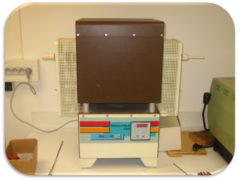
Horizontal furnace
Facility manager: Laurent Tissandier
laurent.tissandier@univ-lorraine.fr
- 200 °C < T < 1200 °C
- Modular furnace, gas mixtures possible
- Glass synthesis, the solubility and speciation of elements in glasses
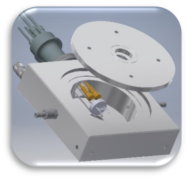
Heating plates
Facility manager: François Faure
francois.faure@univ-lorraine.fr
- Tmax = 2500 °C
- Fluid and magmatic inclusions
- Crystal growth
CONDITIONS OF ACCESS / PRICES
Requests for access to the facility must be made using the contact form, which must be downloaded, completed, and sent to crpg-comax-contact@univ-lorraine.fr. For initial requests or specific questions, it is recommended to contact facility staff in advance (crpg-comax-contact@univ-lorraine.fr). The request will then be discussed by the facility’s steering committee.
All users must accept the facility’s access and working conditions and sign the facility’s user charter (in French or English).
Since November 3, 2025, our pricing is auditable, certified by the CNRS and eligible for ANR and ERC funding decision available on request).
| Private and industry clients | External academic clients | Partner clients | Internal invoicing |
Silica sealed tubes | 363 € | 181 € | 79 € | 79 € |
Nebulotrons | 366 € | 262 € | 110 € | 110 € |
Piston-cylinder | 797 € | 569 € | 217 € | 217 € |
Preparation with crucible | 1343 € | 269 € | 119 € | 119 € |
Preparation without crucible | 742 € | 212 € | 66 € | 66 € |
Vertical furnace with gas | 237 € | 148 € | 66 € | 66 € |
Vertical furnace without gas | 191 € | 137 € | 55 € | 55 € |
PREPARATION OF EXPERIMENTS
Facility users have two options:
– Users are welcome to bring their own starting composition(s) and small supplies if desired.
– It is also possible to prepare starting composition(s) and capsules on-site (see “Preparation” prices). This request must be submitted in advance, before the final quote is established.
FACILITY LIFE
ANR IMPacToR – P.I. Camille Cartier – 2024/2028 – Aubrites: relics of a large proto-planet Mercury?
NASA project– P.I. Sune Nielsen – 2024/2027 – Using Vanadium Isotope Systematics to Probe the Differentiation State of Terrestrial Planets’ Building Blocks.
ERC IRONIS – P.I. Evelyn Füri – 2023/2028 – Light elements in irons and metal-rich meteorites: Their isotopic distribution and evolution in the protoplanetary disk.
CNRS-IRP international ImpactGEM – P.I. Béatrice Luais – 2023/2028
ANR CSI-Planet – P.I. Célia Dalou – 2023/2027 – Carbon and sulfur isotopic fractionation during planetary differentiation.
ANR MARS-Spec – P.I. Jessica Flahaut – 2021/2025 – Contribution of near infrared spectroscopy (VNIR) to the study of the origin and mode of formation of Martian feldspathic rocks.
ANR PlanetGEM – P.I. Béatrice Luais – 2021/2025 – Planet differentiation: an integrated Experimental and numerical Modeling of Germanium isotopic fractionation.
ANR TRANSFAIR – Co-PI Karine Devineau – 2021/2025 – Lithium and critical metals from hard rock deposits: geoenvironmental model and socioeconomic trends.
GECO-REE project– P.I. Lydéric France – 2013/2025 – Genesis and evolution of carbonatites, the main REE deposits. The example of Oldoinyo Lengai (Tanzania). [ANR + LabEx R21 + INSU + Région].
Mahaud Chavanieu – Carbon and Sulfur Isotopic fractionations during magma ocean outgassing: comparison of Earth’s and Mars’ primitive atmosphere. Supervision : Celia Dalou / Laurie Reisberg
Clarisse Peignaux – Identification and origin of Martian granitoids by infrared spectroscopy. Supervision: Jessica Flahaut / François Faure
October 3, 2025 – Baptiste Le Bellego – Experimental approach to the isotopic fractionation of germanium under the conditions of formation of the accretion core of planetesimals. Supervision: Béatrice Luais / Celia Dalou
December 8, 2023 – Dorian Thomassin – Origin of hydrogen in high-temperature phases of chondrites. Supervision: Laurette Piani / Yves Marrocchi
May 26, 2023 – Olivier Podda – Solubility and Speciation of Uranium in Aluminosilicate Liquids. Supervision: Etienne Deloule / Laurent Tissandier / Annabelle Laplace
March 14, 2023 – Nicolas Schnuriger – Redox Conditions for the Formation of Chondrules and Their Precursors. Supervision: Camille Cartier / Yves Marrocchi
April 8, 2022 – Marion Auxerre – Crystallization of Olivines in Barred and Macroporphyritic Chondrules. Supervision: François Faure
December 18, 2020 – Julien Boulliung – Solubility, Speciation, and Diffusion of Nitrogen in Glass and Silicate Melts. Supervision: Evelyn Füri / Yves Marrocchi
membERs
RECENT PUBLICATIONS BY FACILITY STAFF
Anzures, B. A., Parman, S. W., Milliken, R. E., Namur, O., Cartier, C., McCubbin, F. M., … Newville, M. (2025). An oxygen fugacity-temperature-pressure-composition model for sulfide speciation in Mercurian magmas. Geochimica et Cosmochimica Acta, 388, 61-77. https://doi.org/10.1016/j.gca.2024.11.012
Boulliung, J., Wood, B. J., and Mather, T. A. (2025). Volatility of mercury and related volatile metals at magmatic temperatures. Chemical Geology, 123018. https://doi.org/10.1016/j.chemgeo.2025.123018
Salgado, L., Faure, F., and Coquerel, G. (2025). Behaviors of Gas-Rich Crystalline Fluid Inclusions. Crystals, 15(8), 740. https://doi.org/10.3390/cryst15080740
Rudraswami, N. G., Suttle, M. D., Marrocchi, Y., Pandey, M., Tissandier, L., and Villeneuve, J. (2025). Experimental heating of CI chondrite: Empirical constraints on the evolution of micrometeorite O-isotopes during atmospheric entry. Geoscience Frontiers, 16(3), 102046. https://doi.org/10.1016/j.gsf.2025.102046
Cartier, C., Llado, L., Pirotte, H., Tissandier, L., Namur, O., Collinet, M., … and Charlier, B. (2024). Partitioning of nickel and cobalt between metal and silicate melts: Expanding the oxy-barometer to reducing conditions. Geochimica et Cosmochimica Acta, 367, 142-164. https://doi.org/10.1016/j.gca.2023.12.020
Dalou, C., Suer, T. A., Tissandier, L., Ofierska, W. L., Girani, A., and Sossi, P. A. (2024). Review of experimental and analytical techniques to determine H, C, N, and S solubility and metal–silicate partitioning during planetary differentiation. Progress in Earth and Planetary Science, 11(1), 27. https://doi.org/10.1186/s40645-024-00629-8
Dalou, C., Riguet, L., Villeneuve, J., Tissandier, L., Rigaudier, T., Cividini, D., … and Paris, G. (2024). Synthesis and Characterization of Metallic (Fe‐Ni, Fe‐Ni‐Si) Reference Materials for SIMS 34S/32S Measurements. Geostandards and Geoanalytical Research, 48(4), 927-940. https://doi.org/10.1111/ggr.12584
Gattacceca, J., McCubbin, F. M., Grossman, J. N., Schrader, D. L., Cartier, C., Consolmagno, G., … and Zhang, B. (2024). The Meteoritical Bulletin, no. 112. Meteoritics and Planetary Science, 59(7), 1820-1823.https://doi.org/10.1111/maps.14181
Le Bellego, B., Motto-Ros, V., Luais, B., Fabre, C., Dalou, C., Condamine, P., and Tissandier, L. (2024). Semi-quantitative μLIBS mapping of germanium diffusion between metal and silicate during planetary core–mantle segregation. Spectrochimica Acta Part B: Atomic Spectroscopy, 222, 107059. https://doi.org/10.1016/j.sab.2024.107059
Jiusti, J., Regnier, E., Machado, N. M., Ghazzai, M. L., Malivert, V., Neyret, M., and Faure, F. (2023). Precipitation of cerianite crystals and its effect on the rheology of a simplified nuclear glass melt. International Journal of Applied Glass Science, 14(4), 502-521. https://doi.org/10.1111/ijag.16639
Pirotte, H., Cartier, C., Namur, O., Pommier, A., Zhang, Y., Berndt, J., … and Charlier, B. (2023). Internal differentiation and volatile budget of Mercury inferred from the partitioning of heat-producing elements at highly reduced conditions. Icarus, 405, 115699. https://doi.org/10.1016/j.icarus.2023.115699
Suer, T. A., Jackson, C., Grewal, D. S., Dalou, C., and Lichtenberg, T. (2023). The distribution of volatile elements during rocky planet formation. Frontiers in Earth Science, 11, 1159412. https://doi.org/10.3389/feart.2023.1159412
Welsch, B., Faure, F., and First, E. C. (2023). Reappraising crystallization kinetics with overgrowth chronometry: an in-situ study of olivine growth velocities. Journal of Petrology, 64(8), egad055. https://doi.org/10.1093/petrology/egad055
Auxerre, M., Faure, F., and Lequin, D. (2022). The effects of superheating and cooling rate on olivine growth in chondritic liquid. Meteoritics & Planetary Science, 57(8), 1474-1495. https://doi.org/10.1111/maps.13830
Condamine, P., Tournier, S., Charlier, B., Médard, E., Triantafyllou, A., Dalou, C., Tissandier, L., Cartier, C., Füri, E. and Marrocchi, Y. (2022). Influence of intensive parameters and assemblies on friction evolution during piston-cylinder experiments. American Mineralogist: Journal of Earth and Planetary Materials, 107(8), 1575-1581. https://doi.org/10.2138/am-2022-7958
Dalou, C., Deligny, C., and Füri, E. (2022). Nitrogen isotope fractionation during magma ocean degassing: tracing the composition of early Earth’s atmosphere. Geochemical Perspectives Letters, 20, 27-31. https://doi.org/10.7185/geochemlet.2204
Dalou, C., Le Losq, C., Füri, E., and Caumon, M. C. (2022). Redox controls on H and N speciation and intermolecular isotopic fractionations in aqueous fluids at high pressure and high temperature: Insights from in-situ experiments. Frontiers in Earth Science, 10, 973802. https://doi.org/10.3389/feart.2022.973802
Faure, F., Auxerre, M., and Casola, V. (2022). Slow cooling during crystallisation of barred olivine chondrules. Earth and Planetary Science Letters, 593, 117649. https://doi.org/10.1016/j.epsl.2022.117649
Hammouda, T., Boyet, M., Frossard, P., and Cartier, C. (2022). The message of oldhamites from enstatite chondrites. Progress in Earth and Planetary Science, 9(1), 13. https://doi.org/10.1186/s40645-022-00471-w
Schnuriger, N., Cartier, C., Villeneuve, J., Batanova, V., Regnault, M., and Marrocchi, Y. (2022). Spinel in CV chondrules: Investigating precursor legacy and chondrule thermal histories. Meteoritics and Planetary Science, 57(5), 1018-1037. https://doi.org/10.1111/maps.13802
Barbey, P., Grandprat, M., and Faure, F. (2021). Cordierite-bearing orbicules record bulk assimilation and the pulsating nature of magma ascent: The Lafaye Orbicular Granite (France). Journal of Petrology, 62(7), egab063. https://doi.org/10.1093/petrology/egab063
Boulliung, J., Dalou, C., Tissandier, L., Füri, E., and Marrocchi, Y. (2021). Nitrogen diffusion in silicate melts under reducing conditions. American Mineralogist, 106, 662–666. https://doi.org/10.2138/am-2021-7799CCBYNCND
Chevreux, P., Tissandier, L., Laplace, A., Vitova, T., Bahl, S., Le Guyadec, F., et al. (2021). Uranium solubility and speciation in reductive soda-lime aluminosilicate glass melts. Journal of Nuclear Materials, 544, 152666. https://doi.org/10.1016/j.jnucmat.2020.152666
Martel, C., Pichavant, M., Di Carlo, I., Champallier, R., Wille, G., Castro, J. M., Devineau, K. and Kushnir, A. R. (2021). Experimental constraints on the crystallization of silica phases in silicic magmas. Journal of Petrology, 62(1), egab004. https://doi.org/10.1093/petrology/egab004
Anzures, B. A., Parman, S. W., Milliken, R. E., Namur, O., Cartier, C., and Wang, S. (2020). Effect of sulfur speciation on chemical and physical properties of very reduced mercurian melts. Geochimica et Cosmochimica Acta, 286, 1-18. https://doi.org/10.1016/j.gca.2020.07.024
Baudouin, C., France, L., Boulanger, M., Dalou, C., and Devidal, J. L. (2020). Trace element partitioning between clinopyroxene and alkaline magmas: parametrization and role of M1 site on HREE enrichment in clinopyroxenes. Contributions to Mineralogy and Petrology, 175(5), 42. https://doi.org/10.1007/s00410-020-01680-6
Boulliung, J., Füri, E., Dalou, C., Tissandier, L., Zimmermann, L., and Marrocchi, Y. (2020). Oxygen fugacity and melt composition controls on nitrogen solubility in silicate melts. Geochimica et Cosmochimica Acta, 284, 120–133. https://doi.org/10.1016/j.gca.2020.06.020
Cartier, C., Namur, O., Nittler, L. R., Weider, S. Z., Crapster-Pregont, E., Vorburger, A., … and Charlier, B. (2020). No FeS layer in mercury? Evidence from Ti/Al measured by MESSENGER. Earth and Planetary Science Letters, 534, 116108. https://doi.org/10.1016/j.epsl.2020.116108
Devineau, K., Champallier, R., and Pichavant, M. (2020). Dynamic crystallization of a haplogranitic melt: application to pegmatites. Journal of Petrology, 61(5), egaa054. https://doi.org/10.1093/petrology/egaa054
Faure, F. (2020). Early silica crust formation in planetesimals by metastable silica-rich liquid immiscibility or cristobalite crystallisation: the possible origin of silica-rich chondrules. Scientific reports, 10(1), 4765. https://doi.org/10.1038/s41598-020-61806-5
Cartier, C., and Wood, B. J. (2019). The role of reducing conditions in building Mercury. Elements: An International Magazine of Mineralogy, Geochemistry, and Petrology, 15(1), 39-45. https://doi.org/10.2138/gselements.15.1.39
Dalou, C., Füri, E., Deligny, C., Piani, L., Caumon, M. C., Laumonier, M., Boulliung J. and Edén, M. (2019). Redox control on nitrogen isotope fractionation during planetary core formation. Proceedings of the National Academy of Sciences, 116(29), 14485-14494. https://doi.org/10.1073/pnas.1820719116
Dalou, C., Hirschmann, M. M., Jacobsen, S. D., and Le Losq, C. (2019). Raman spectroscopy study of COHN speciation in reduced basaltic glasses: Implications for reduced planetary mantles. Geochimica et Cosmochimica Acta, 265, 32-47. https://doi.org/10.1016/j.gca.2019.08.029
Mosenfelder, J. L., Von Der Handt, A., Füri, E., Dalou, C., Hervig, R. L., Rossman, G. R., & Hirschmann, M. M. (2019). Nitrogen incorporation in silicates and metals: Results from SIMS, EPMA, FTIR, and laser-extraction mass spectrometry. American Mineralogist: Journal of Earth and Planetary Materials, 104(1), 31-46. https://doi.org/10.2138/am-2019-6533
Rose-Koga, E. F., Koga, K. T., Devidal, J. L., Shimizu, N., Voyer, M. L., Dalou, C., and Döbeli, M. (2020). In-situ measurements of magmatic volatile elements, F, S, and Cl, by electron microprobe, secondary ion mass spectrometry, and heavy ion elastic recoil detection analysis. American Mineralogist, 105(5), 616-626. https://doi.org/10.1016/j.chemgeo.2008.10.005
Giuliani, G., Pignatelli, I., Lheur, C., Feneyrol, J., Claiser, N., Tissandier, L., et al. (2019). Les zoïsites de Canari (France) et Merelani (Tanzanie) : similitudes et différences. Le Règne Minéral, 149, 20–51.
Vacher, L. G., Truche, L., Faure, F., Tissandier, L., Mosser-Ruck, R., and Marrocchi, Y. (2019). Deciphering the conditions of tochilinite and cronstedtite formation in CM chondrites from low temperature hydrothermal experiments. Meteoritics & Planetary Science, 54, 1870–1889. https://doi.org/10.1111/maps.13317
Amalberti, J., Burnard, P., Tissandier, L., and Laporte, D. (2018). The diffusion coefficients of noble gases (He-Ar) in a synthetic basaltic liquid: One-dimensional diffusion experiments. Chemical Geology, 480, 35–43. https://doi.org/10.1016/j.chemgeo.2017.05.017
Bekaert, D. V., Derenne, S., Tissandier, L., Marrocchi, Y., Charnoz, S., Anquetil, C., et al. (2018). High-temperature ionization-induced synthesis of biologically relevant molecules in the protosolar nebula. Astrophysical Journal, 859(142). https://doi.org/10.3847/1538-4357/aabe7a
Dalou, C., Boulon, J., Koga, K. T., Dalou, R., & Dennen, R. L. (2018). DOUBLE FIT: Optimization procedure applied to lattice strain model. Computers and Geosciences, 117, 49-56. https://doi.org/10.1016/j.cageo.2018.04.013
Florentin, L., Deloule, E., Faure, F., and Mangin, D. (2018). Chemical 3D-imaging of glass inclusions from allende (CV3) olivine via SIMS: A new insight on chondrule formation conditions. Geochimica et Cosmochimica Acta, 230, 83–93. https://doi.org/10.1016/j.gca.2018.03.021
Fournier, J., Régnier, E., Faure, F., Le Goff, X., Brau, H. P., Brackx, E., et al. (2018). Application of the JMAK model for crystal dissolution kinetics in a borosilicate melt. Journal of Non-Crystalline Solids, 489, 77–83. https://doi.org/10.1016/j.jnoncrysol.2018.03.018
Fournier, J., Régnier, E., Faure, F., Le Goff, X., Brau, H. P., Brackx, E., et al. (2018). Modeling of dissolution kinetics of rare earth crystals in a borosilicate glass melt. Journal of Non-Crystalline Solids, 481, 248–253. https://doi.org/10.1016/j.jnoncrysol.2017.10.042
Füri, E., Deloule, E., and Dalou, C. (2018). Nitrogen abundance and isotope analysis of silicate glasses by secondary ionization mass spectrometry. Chemical Geology, 493, 327-337. https://doi.org/10.1016/j.chemgeo.2018.06.008
Dalou, C., Hirschmann, M. M., von der Handt, A., Mosenfelder, J., and Armstrong, L. S. (2017). Nitrogen and carbon fractionation during core–mantle differentiation at shallow depth. Earth and Planetary Science Letters, 458, 141-151. https://doi.org/10.1016/j.epsl.2016.10.026
Faure, F., Tissandier, L., Florentin, L., and Devineau, K. (2017). A magmatic origin for silica-rich glass inclusions hosted in porphyritic magnesian olivines in chondrules: An experimental study. Geochimica et Cosmochimica Acta, 204, 19-31. https://doi.org/10.1016/j.gca.2017.01.034
Florentin, L., Faure, F., Deloule, E., Tissandier, L., Gurenko, A., and Lequin, D. (2017). Origin of Na in glass inclusions hosted in olivine from Allende CV3 and Jbilet Winselwan CM2: Implications for chondrule formation. Earth and Planetary Science Letters, 474, 160–171. https://doi.org/10.1016/j.epsl.2017.06.038
Kuga, M., Cernogora, G., Marrocchi, Y., Tissandier, L., and Marty, B. (2017). Processes of noble gas elemental and isotopic fractionations in plasma-produced organic solids: Cosmochemical implications. Geochimica et Cosmochimica Acta, 217, 219–230. https://doi.org/10.1016/j.gca.2017.08.031
Le Losq, C., Dalou, C., and Mysen, B. O. (2017). In situ study at high pressure and temperature of the environment of water in hydrous Na and Ca aluminosilicate melts and coexisting aqueous fluids. Journal of Geophysical Research: Solid Earth, 122(7), 4888-4899. https://doi.org/10.1002/2017JB014262
Soulié, C., Libourel, G., and Tissandier, L. (2017). Olivine dissolution in molten silicates: An experimental study with application to chondrule formation. Meteoritics and Planetary Science, 52(2), 225-250.https://doi.org/10.1111/maps.12792
Tissandier, L., and Rollion-Bard, C. (2017). Influence of glass composition on secondary ion mass spectrometry instrumental mass fractionation for Si and Ca isotopic analyses. Rapid Communications in Mass Spectrometry, 31, 351–361.https://doi.org/10.1002/rcm.7799
Tissandier, L., Florentin, L., Lequin, D., Baillot, P., and Faure, F. (2017). A new heating stage for high temperature/low fO2 conditions. Journal of Crystal Growth, 458, 72–79. https://doi.org/10.1016/j.jcrysgro.2016.11.043












